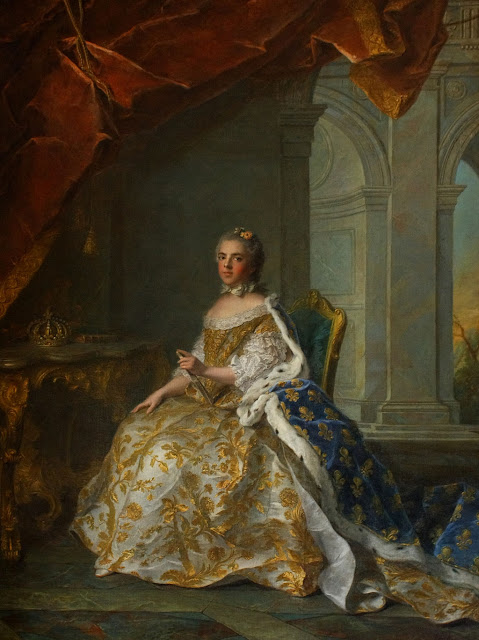Louise Élisabeth of France
Louise Élisabeth de France, Duchess of Parma, in court dress, by Jean-Marc Nattier, (posthumous, 1761)
Early life
Marie Louise Élisabeth de France and her twin sister Henriette de France were born at the Palace of Versailles on 14 August 1727 to Louis XV of France and his wife, the Polish born queen, Maria Leszczyńska. With her younger twin, she was baptised at Versailles on 27 April 1737. She was known at court as Madame Royale, Madame Première, Madame Élisabeth, and also as Babette within her family circle.
She was said to resemble her father and was his favourite daughter.
She was put in the care of Marie Isabelle de Rohan, duchesse de Tallard.
Élisabeth was raised at Versailles with her twin sister, Henriette, their younger sisters Marie-Louise, Marie Adélaïde, and their brother, the Dauphin. She was known to be very intelligent and a quick learner. She and her brother were the only ones who got married, and only Adélaïde and Victoire lived to see the fall of the Ancien Régime under the reign of their nephew, Louis XVI.
Unlike her younger sisters Sophie and Victoire, who were raised in the strict environment of the royal Abbey at Fontevraud, Élisabeth grew up within a loving family circle at Versailles.
Élisabeth in hunting dress, by Jean-Marc Nattier
Marriage
Her prospective engagement to the Infante Philip of Spain was announced at court in February 1739, when she was eleven years old. Philip was the third son of Louis XV's uncle, Philip V d'Anjou, King of Spain, and of his second wife, Elizabeth of Parma. Through his mother, he inherited the Duchy of Parma and with his wife founded the House of Bourbon-Parma.
This engagement followed a tradition dating back to 1559 of cementing military and political alliances between the Catholic powers of France and Spain with royal marriages. Despite this and the fact that Philip was her father's first cousin, the announcement of the marriage agreement was not well received at the French court, as there was little chance that Philip would become King of Spain.
The twelve-year-old Élisabeth was married by proxy on 26 August 1739, not having met her future husband beforehand. Afterwards, she was known as Madame Infante at the court of Louis XV.
She met her nineteen-year-old husband some thirty kilometers northeast of Madrid, at Alcalá de Henares, where the marriage ceremony took place on 25 October 1739.
Children
The marriage was not a happy one. The couple had three children:
Isabella Maria Luisa Antonietta Ferdinanda Giuseppina Saveria Dominica Giovanna (1741–1763) who later married the Austrian emperor, Joseph II, queen Marie Antoinette's older brother. Both of her children died in childhood.
• Ferdinand Maria Filippo Lodovico Sebastiano Francesco Giacomo (1751–1802) who succeeded his father as Duke of Parma in 1765 and married Archduchess Maria Amalia of Austria, his older sister's sister-in-law, and left issue.
• Luisa Maria Teresa Ana (1751–1819), known as Maria Luisa who married Infante Charles of Spain, her cousin, and later became the Queen consort of Spain. She left issue.
Élisabeth with her husband and their children Ferdinand and Maria Luisa; Isabella is shown in a white dress; by Giuseppe Baldrighi
Spain
At the time of Élisabeth's arrival in Spain, etiquette at the Spanish Court was much stricter than that in Versailles, and, to make matters worse, Élisabeth discovered that her mother-in-law, Elisabeth of Parma, was domineering. As a result, she spent most of her time away from the Queen, playing with dolls. Élisabeth wrote of her unhappiness to her father. On 31 December 1741, at the age of fourteen, she gave birth to her first child, Isabella, who was named after the Queen, (Elisabeth is Isabel in Spanish).
In 1745, Philip's younger sister, Infanta Maria Teresa Rafaela of Spain, was married to Élisabeth's brother Louis, the Dauphin of France.
Parma
Élisabeth was able to leave Spain in 1748. In the Treaty of Aix-la-Chapelle (1748) which ended the War of the Austrian Succession, Holy Roman Empress Maria Theresa had to cede the duchies of Parma, Piacenza and Guastalla to her enemy, Philip V of Spain. At Louis XV's instigation, Philip and Élisabeth became Duke and Duchess of Parma.
Versailles
En route to Parma, Élisabeth first went to Versailles where she arrived on 11 December 1748. During her several-month stay in Versailles, she became acquainted with Madame de Pompadour, her father's maîtresse-en-titre.
During this first return visit to France, a courtier described Élisabeth as "charming" and as having "piercing eyes" that "express(ed) intelligence" while another, less sympathetic observer claimed she looked like a "well-endowed young woman, matured by motherhood". She arrived in Parma in October 1749. While in Parma, she and her husband lived in the Ducal Palace of Colorno In 1751, she gave birth to her children Ferdinand and Maria Luisa.
Élisabeth's twin sister Henriette died in 1752, and Élisabeth returned to France in September, visiting her tomb at Saint-Denis and remaining in Versailles for almost a year.
Élisabeth returned to France again in September 1757, to arrange the marriage of her daughter Isabella to the Archduke Joseph of Austria, the future Emperor Joseph II, which took place in 1760.
King Ferdinand VI of Spain died without an heir in August 1759 and was succeeded by his younger (and Philip's older) brother Carlos, who became Charles III of Spain.
Élisabeth fell ill while she was at Versailles, and died of smallpox on 6 December 1759 and was buried on 27 March 1760 at Saint-Denis Basilica beside her twin, Henriette. Their tombs were desecrated in 1793, during the French Revolution.
Élisabeth as Duchess of Parma, by Charles-André van Loo
Posted by Vielka Helen - Princess Eboli







No comments:
Post a Comment